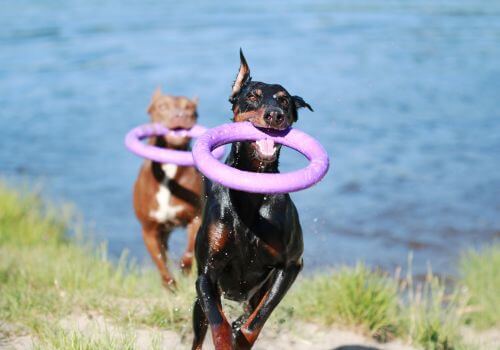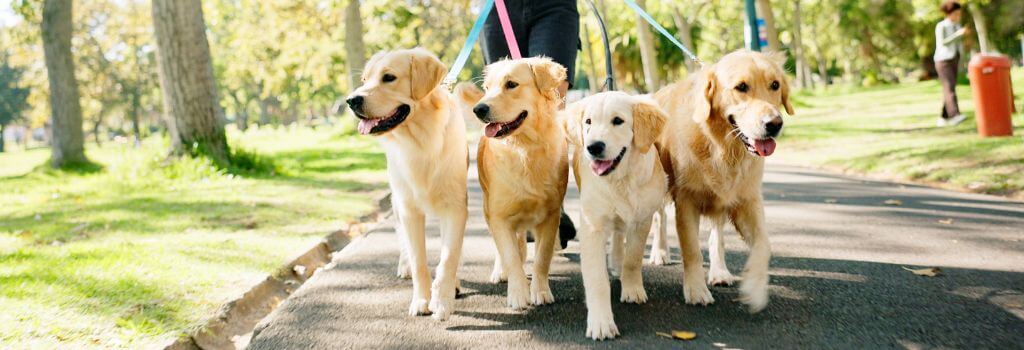As pet owners, we want the best for our furry friends. As you know, dogs need exercise and activity for optimal physical and mental health. Regular activity also helps with preventing destructive behaviors. At Glen Oak Dog & Cat Hospital, we understand the importance of providing adequate exercise to suit your dog’s age and breed. In this article, we will discuss how much activity your dog needs, how their activity level affects their behavior, and the different kinds of fun activities that you can do with your dog. With our help, you can keep your pup happy and healthy! And if you are located in or near Glenview, IL, we are here to help you better understand your canine companion’s needs.
How Much Activity Does My Dog Need for Optimal Health?
The amount of activity your dog needs depends on factors including their age, breed, and overall health. Generally, dogs need between 30 minutes to 2 hours of exercise daily to maintain optimal health. Puppies need multiple short bursts of activity and playtime rather than long walks. An adult dog’s exercise requirements are heavily influenced by their breed. High-energy breeds like Border Collies and Belgian Malinois need more exercise than lower-energy breeds like Bulldogs or Basset Hounds. It's essential to tailor the exercise routine to your dog’s breed, size, and energy level.
Regular exercise is vital for maintaining a healthy weight, muscle tone, metabolism, and mental stimulation. Exercise can also help prevent destructive behaviors and alleviate stress in dogs. Some recommendations for daily exercise based on breed groups include:
- Sporting Breeds: 1 hour
- Large Breeds: 1-1.5 hours
- Terriers and Medium-Sized Breeds: 1-2 hours
- Small and Toy Breeds: 30 minutes
Monitor your dog’s response to exercise and adjust the routine if needed. If you need help, consult with your veterinarian to determine the appropriate exercise regimen for your pup!

How Does the Ideal Activity Level Change Based on Age and Breed?
Puppies need to exercise in short bursts throughout the day. This prevents overexerting their growing joints and bones. As puppies grow into adults, their ideal activity level changes based on their breed. High-energy breeds such as Retrievers and Setters need 1 to 2 hours of moderate-intensity exercise daily, while toy or small dog breeds only require 30 minutes. For working breeds like Siberian Huskies and Saint Bernards, a substantial amount of exercise is recommended; activities like long walks and hikes should be part of their routine. Senior dogs may not have the same energy levels as younger dogs but still need regular physical activity and mental stimulation to maintain mobility and mental health. Swimming or other low-impact exercises are great options for senior dogs. Talk to your veterinarian if you’re unsure how to exercise your older canine companion.
What Health Problems Can Arise in Dogs That Don’t Get Enough Activity?
A lack of exercise in dogs can lead to various health issues affecting their physical, mental, and emotional well-being. Weight gain is one of the most common health problems among inactive dogs. If your pup isn’t getting enough exercise, they may become obese. Obesity can lead to other health problems like heart disease, diabetes, and joint issues. Inactive dogs also tend to have weaker muscles, making them more prone to injuries and joint problems. Poor cardiovascular health is another consequence of insufficient activity.
How Does a Dog’s Activity Level Affect Their Behavior?
Regular exercise and playtime can positively impact your dog’s behavior. Exercise reduces dogs' anxiety, fear, and aggression by releasing endorphins that make them feel happier. It also helps them build trust and confidence in their owners and the environment, making them better behaved. Regular exercise is also essential for mentally stimulating your dog since boredom can lead to destructive behaviors like chewing furniture or barking excessively. Providing your pup with the right amount of activity for their age and breed promotes better overall behavior.

What Should I Do to Deal With Destructive Activities and Behaviors?
Destructive pet behaviors occur due to various problems, such as teething in puppies, medical problems, separation anxiety, attention-seeking, fear, and boredom. To address these issues effectively, be attentive to your pet's needs, and provide them with a secure designated space when left alone. Put away all items your dog can get into their mouth to prevent access to chewable items. Regular exercise and mental stimulation are also essential for reducing destructive behaviors in pets. Daily walks or cardio games are essential because they help release pent-up energy. If the behavior is anxiety-related, consult your veterinarian or a behavior specialist to address the underlying issue.
What Are Some Fun Activities I Can Do with My Dog?
You can do countless activities to spend quality time with your dog and keep them active. Going for walks around the neighborhood or exploring a nearby park is a great way to bond with your pet and provide them with exercise. You can also take them on bike rides and swimming trips or bring them along for your next run. If you’re looking for something different, why not try an app-based scavenger hunt or take your pet to a pet-friendly hotel? It’s also fun to teach your dog new tricks to provide mental exercise.

What If My Dog Is Lethargic and Won’t Exercise?
Just like for people, dogs will need to work up to an elite level of fitness if they are not used to it. Start slow and gradually increase the length of walks and runs, always being mindful of the temperature outside. But, lethargy and exercise intolerance in dogs can be early signs of various health issues, some of which can be life-threatening if not addressed promptly. As a pet owner, it's essential to understand the possible causes and take appropriate action to ensure your furry friend’s well-being. Possible causes of lethargy and exercise intolerance include:
- Infections
- Pain
- Arthritis
- Metabolic and Organ Disease
- Anemia
- Anxiety
- Heart Problems
- Hypothyroidism
- Side Effects of Medication
- Poisoning
- Trauma
- Pulmonary Hypertension
Signs of exercise intolerance and lethargy include excessive sleepiness, delayed response to commands or hesitance to go for walks or play with toys. If your dog is lethargic or won't exercise, monitor their behavior closely and note any additional symptoms. Consult your veterinarian immediately to discuss your pet’s symptoms and determine if further examination or testing is necessary. Follow their recommendations for treatment or management of the underlying cause. Ensure your dog receives proper nutrition, hydration, and care to support their overall health and well-being.
Conclusion
Regular exercise is essential for maintaining your dog’s physical and mental health. At Glen Oak Dog & Cat Hospital, we understand the importance of providing the right amount of activity based on their age and breed. We can help you develop a tailored exercise routine to keep your four-legged family member healthy and happy. With our support, you can give your pup the best care possible! If your dog needs a veterinarian in Glenview, IL, give us a call at (276) 600-2631 today to schedule an appointment. We look forward to speaking with you!

